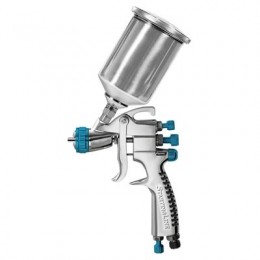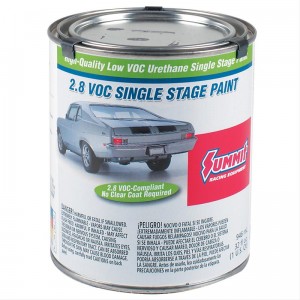What’s the latest trend in automotive paint?
Green.
Not the color green, necessarily. We’re talking “green” as in environmentally friendly automotive paints. These are paints that meet environmental regulations for Volatile Organic Compounds (VOCs) within paints and coatings. Found in traditional solvent-based paints, VOCs are essentially solvents that are emitted into the atmosphere as gases while the paint dries. Certain areas of the United States have mandated a limited amount of VOCs be used in automotive paints (and paint in general) because of environmental concerns.
Whether you like it or not, these regulations (which began in Southern California) are quickly spreading to many other areas of the United States. Aftermarket parts companies are now unable to sell paints with a typical VOC levels to many parts of the United States, as well as Canada and other overseas locations. The list of places continues to grow. Fortunately, paint companies have developed a wider variety of Low VOC options available through companies like Summit Racing.
The key is to educate yourself on options. In doing so, you’ll be able to spray a professional paint job at home while meeting the laws of the paint police.
Paint Anatomy 101
When it comes to Low VOC paint options, you have two main choices: solvent-based (acrylic urethane) or waterborne. To understand the difference, you simply need to know the basic physical make-up of automotive paint.
Automotive paint is made up of three parts: the pigment, the binding agent, and the carrier agent. The pigment is essentially the color. The binding agent is the chemical that typically bonds the pigment to the vehicle’s surface. The carrier agent is tasked with suspending the pigment until it is applied to the surface via the paint gun. Once the paint dries, the carrier agent evaporates into the atmosphere.
The difference between solvent-based and waterborne paint lies within the carrier agent. As the chemical and associated VOCs in solvent paints dry up, they are emitted into the atmosphere. Conversely, when the water in waterborne paint dries up, it simply evaporates. While waterborne, or water-based, paints are easier on the environment than solvent-based options, many paint companies have created Low VOC versions of their solvent-based paints for those who would still prefer an acrylic urethane or other solvent paint.
So What is Considered Low VOC?
For compliance in areas with Low VOC regulations, the VOC limit is 3.5 pounds-per-gallon for basecoats, 2.8 pounds-per-gallon for topcoats (single-stage paint), and 2.1 pounds-per-gallon for primers and clears. The charts below provide a good rundown and comparison between Low VOC paints (top) and National Rule (bottom).
Low VOC Limits
| Product Category | CARB/Low VOC Limit |
|---|---|
| Primer Sealer | 2.1 lbs./gallon |
| Primer Surfacer | 2.1 lbs./gallon |
| Topcoat (Single Stage) | 2.8 lbs./gallon |
| Basecoat | 3.5 lbs./gallon |
| Clearcoat | 2.1 lbs./gallon |
National Rule Limits
| Product Category | National Rule Limit |
|---|---|
| Primer Sealer | 4.6 lbs./gallon |
| Primer Surfacer | 4.8 lbs./gallon |
| Topcoat (Single Stage) | 5.0 lbs./gallon |
| Basecoat/Clearcoat | 5.0 lbs./gallon [BC = (2xCC)/3] |
| Multi-stage BC/CC | 5.2 lbs./gallon [BC = (2xCC)/3] |
The Solvent Solution
One common misconception is that certain states with strict VOC emissions standards mandate use of waterborne paint.
This is simply not true.
There is no area within the United States (no, not even California) that requires waterborne paint. To meet the stricter Low VOC standards sweeping across the United States, many paint manufacturers (from Dupont and Valspar to Summit Racing) have developed Low VOC versions of their solvent-based paints. These paints meet the Low VOC levels outlined in the chart above by using special chemicals that lower the total VOCs. At the same time, they deliver many of the same benefits and application characteristics as the traditional solvent-based paints while using the same equipment.
Summit Racing, for example, offers three Low VOC versions of its paint line. Its traditional and Hot Rod Flat single-stage paint is a 2.8 VOC paint that combines the basecoat and clearcoat into one system. The company offers a complete VOC single stage paint system, which includes the necessary 2.8 VOC hardeners for proper curing. The Summit Racing two-stage paint combines a 3.5 VOC basecoat with a separate 2.1 VOC clear to meet the stricter requirements. The company also carries a 2.1 VOC primer, along with support products like reducer to give you a professional finish.
The biggest advantage to going with a solvent-based Low VOC paint is that it is inexpensive and probably compatible with your existing paint equipment. If you’re accustomed to spraying a solvent-based paint, you may notice slight differences in the spray characteristics but it’s largely the same process that you’ve perfected on past paint jobs. Plus, sticking with a solvent-based Low VOC paint will allow you to use your existing paint equipment.
The Water Way
You may also consider making the switch to waterborne paint to meet Low VOC requirements.

Waterborne paints require stainless steel paint guns which will resist corrosion from the water within the paint.
By using water instead of chemicals as a carrier agent, waterborne paints all but eliminate the VOCs found in the basecoat. Keep in mind, though, that waterborne paints are typically a basecoat/clearcoat system, which means the clearcoat you select will need to comply to the VOC requirements of your local area. Many companies still offer solvent-based primers and clears to go with their waterborne paint; however, there are some water-based primers and clears available through select companies.
There are advantages and disadvantages to using waterborne paint. Waterborne paint is generally more expensive than Low VOC solvent-based paints, but it provides excellent coverage. If your time is at a premium, keep in mind that waterborne paints also have a slower drying time than solvent-based paints, so they do require a little patience during the application process. For this reason, professional shop owners opt to have specialized drying systems installed. At the very least, you’ll need to upgrade to a stainless steel paint gun to prevent corrosion from the water within the paint.
Do I Need Low VOC Paint?
Although California started the ball rolling on Low VOC requirements, the trend has spread quickly. As of April 2015, areas in the following states had Low VOC restrictions, according to Summit Racing:
- California
- Connecticut
- Washington, D.C.
- Delaware
- Illinois
- Indiana
- Massachusetts
- Maine
- Maryland
- Michigan
- New Hampshire
- New Jersey
- New York
- Pennsylvania
- Rhode Island
- Vermont
- Virginia
- Utah
The best advice for ordering paint for a DIY paint job is to check local laws. The list of states and regions adhering to Low VOC regulations is rapidly growing, and paint suppliers can’t ship non-Low VOC products to these areas.
Fortunately, that doesn’t mean your paint plans have hit a roadblock.
It just means a quick detour to one one of the many Low VOC and waterborne paint options now available.


Enjoy these updates, helps keep me current, along with providing a good reason to do business with you. Thank you.
[…] on using, and the epoxy primer i used on my cab apparently do not meet the low VOC requirement. The Low VOC Lowdown: The DIYer's Guide to Low VOC Automotive Paint – OnAllCylinders ame_toggle_view({other : 'true',post : 'true',blog : 'true',group : 'true',vm : 'true',sig […]
I am preparing to paint my boat trailer With 2.8 voc single stage paint urethane. SUM-LVS311G.
I don’t see any directions for mixing with activator, or dry/re-coat times?
I will be brushing and rolling the paint on.
https://www.summitracing.com/parts/sum-lvs311g
Can i use a chemical based clear coat on a waterbased paint iam getting debris in clear coat is it a chemical reaction
Where can I purchase waterborne paint to do small auto paint touch-ups at home?
Hey Jim,
Did you mean waterborne aerosol paint? You can find a ton of waterborne paint options here.
[…] doing your part to protect the planet, you may want to consider asking your auto body shop to use low VOC products when repairing your vehicle. Low VOC paints have been engineered to have fewer harmful chemicals. […]
Great article David!!!
I am a new DIYer and am looking forward to becoming a great automotive painter.. I haven’t done anything yet actually 🙁 but I am looking for paint and this article just helped me to get one step closer to knowing what I am doing. 🙂
TheoN
[…] The Low VOC Lowdown: The DIYer’s Guide to Low VOC […]